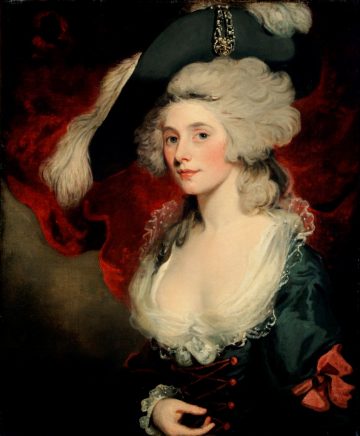

Author: Landon, Letitia Elizabeth (1802-38)
Title:The Golden Violet, with its Tales of Romance and Chivalry; with Other Poems
Date: 1827
Biographical Information
Letitia Elizabeth Landon, also known as L.E.L., was born on August 14th, 1802 to John Landon and Catherine Jane Bishop at No. 25 Hans Place, Chelsea. Letitia began a formal education at age 6, studying under the future Countess St. Quentin, which contributed to her love of poetry and her faultless French accent. When Letitia was seven years old, she studied history, geography, grammar, and literature as she studied under her cousin Elizabeth Landon after her family moved to Trevor Park, East Barnet. Letitia loved to read, even though novels were forbidden. Her formal education ended in 1814 after her family began having financial difficulties that finally caused them to move to Lewis Place, Fulham and Old Brompton a year later.
Landon’s first work was first published on March 11, 1818, after her mother asked the Landons’ neighbor, the editor of the Literary Gazette, to read some of her works. That neighbor, William Jerdan, went on to become Letitia’s mentor as she published her poems. Landon signed her work with the letter “L” until 1821 when she began to sign her name with her initials “L.E.L.” Landon quickly developed the reputation for producing many works in a short period of time, which caused controversial opinions on the importance of her work because of the rapidity of its composition. Some critics believed that her work was monotonous, while others praised her creativity. Landon used the proceeds of her works to help support her family, especially after her father’s death, which left her as the sole financial provider. As well as writing for the Literary Gazette, Landon contributed to the New Monthly Magazine, the Court Journal, Fairy Almanac, and eventually became editor of the Drawing-Room Scrap-Book.
In 1836, after many rumors of affairs with different men, Landon met George Maclean, the governor of Cape Coast, Africa. On June 7, 1838, Landon’s brother performed a small, private wedding ceremony for Letitia and George before the couple made the voyage back to Africa with an agreement that Landon would be able to return to England after three years if she wished to do so. Landon had always been fascinated by Africa and enjoyed her time in Cape Coast, often writing letters to her brother about Africa and how happy she was.
On Monday, October 15, 1838 Letitia Elizabeth Landon was found dead in her room by one of the servants. Landon was found with a bottle of prussic acid in her hand, a commonly prescribed drug which she regularly used as a medicine to calm her nerves. Due to the lack of an autopsy, the cause of Landon’s death was immediately debated between suicide and murder. Her husband suggested that she overdosed on her medication, while others believed a native woman who had earlier borne Maclean’s child was the cause. Landon’s mysterious and still unexplained death remain highly debated to this day.
Sources
Feldman, Paula R., editor. British Women Poets of the Romantic Era. The John Hopkins
University Press, 1997.
Fraistat Neil. "Life of Letitia Elizabeth Landon." Romantic Circles, edited by Dave Rettenmaier,
University of Maryland, Oct. 1998, www.rc.umd.edu/editions/lel/lelbio.htm. Accessed 2 May 2018.
Lawford, Cynthia. "Letitia Elizabeth Landon: A Biography." Women's Writing, vol. 18, no. 3, Aug. 2011, pp. 444-447. EBSCOhost, doi:10.1080/09699082.2011.577303.
Prepared by Haley Eustice, University of Nebraska, Spring 2018
© Haley Eustice, 2018